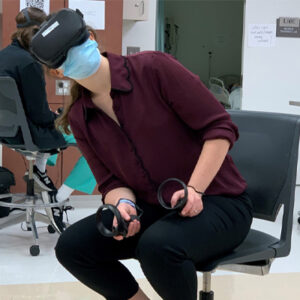Cataract: Best practices
July 2023
by Liz Hillman
Editorial Co-Director
The cataract patient who has had prior refractive surgery requires extra considerations in terms of consultations/patient expectations, IOL selection, formulas, use of intraoperative technologies, and postoperative potential.
Nicole Fram, MD, and Warren Hill, MD, provided their thoughts on the modern management of these cataract patients.
Preoperative/consult period
Dr. Fram said that the first step is to take a thorough history, determining whether the patient was of presbyopic age when they had laser vision correction, what type they received, and if monovision was a strategy used for presbyopia correction.
“It is also important to review their current glasses prescription and ask direct questions such as, ‘Do you currently wear glasses when you look at your phone or computer, when reading and/or driving at night?’ I will even go as far as asking to see the font on their phone to assess their level of presbyopia denial,” Dr. Fram said. “All of these questions will help you assess the proper timing of surgery and strategy necessary to achieve the highest patient satisfaction.”
In her diagnostic workup, Dr. Fram includes manifest refraction, pachymetry, corneal topography with Placido imaging, wavefront or ray tracing technology (to determine the level of spherical aberrations and higher order aberrations originating from the cornea or the lens/vitreous), and a spectral-domain macular OCT. Dr. Fram said the type of refractive treatment (myopic or hyperopic) and centration of the ablation is also important for counseling. She finds Placido imaging useful to assess quality of vision potential to set expectations.
In counseling, Dr. Fram said she uses her tablet to display Rendia Exam Mode and describe how the light travels in the eye. She explains to the patient how laser vision correction affects one of the important parameters used to calculate IOL power and the potential for inaccuracies.
“I explain that although we are improving our ability to achieve emmetropia and hit the targeted outcome, there is still a chance they may need glasses postoperatively,” she said.
Dr. Hill said that he takes preoperative measurements in a separate visit. “During this visit, I review these with the patient using a large, wall-mounted LED display screen connected to each of our instruments. The discussion concentrates on the topographic axial curvature map and an image simulation at various pupil sizes, with and without glasses; explaining to the patient how they will see after surgery is good, but showing them is far better,” Dr. Hill said.

Source: Nicole Fram, MD
IOL selection
IOL selection, Dr. Fram said, depends on patient expectations and type of ablation pattern. The post-myopic LASIK patient, for example, will usually have a positive or neutral spherical aberration profile, so an IOL with negative spherical aberration or neutral spherical is theoretically preferred, Dr. Fram said. Conversely, a patient with a hyperopic ablation, which Dr. Fram said is more challenging to obtain consistent keratometry measurements with, can cause negative or neutral spherical aberration. This, with a small pupil, can lead to a multifocal-like outcome. If the patient was previously happy with this ablation pattern without cataracts, Dr. Fram said she’ll often choose IOLs with zero spherical aberration.
“The question often arises whether to choose an EDOF or diffractive multifocal/trifocal technology in the post-corneal refractive population,” Dr. Fram continued. “There are many reports of excellent outcomes with this technology. In our experience, the ablation needs to be well centered with normal Placido imaging in order to have a satisfied patient. Some refer to the EDOF technology as ‘more forgiving’ than a multifocal or diffractive technology. However, if a surgeon is going to use this technology, they need to be prepared to remove the IOL because up to 19% of post-LASIK patients had to have an IOL exchange due to diffractive dysphotopsia, according to our research.”1
This is where Dr. Fram finds the Light Adjustable Lens (LAL, RxSight) beneficial. “The LAL has been a huge boost for our practice in the post-LASIK/PRK patient population [because] the IOL targeting can be adjusted postoperatively and is less reliant on current IOL calculations,” she said. “This has become my preferred technique due to the postoperative adjustability, and the silicone IOL lends itself to a lower dysphotopsia profile in these already aberrated corneas.”
While it’s still necessary with the LAL for the patient to have a well-centered ablation, normal Placido imaging, and a pupil that can dilate to at least 6.5 mm, Dr. Fram said the technology can achieve a customized mini-monovision without the need to disassociate the eyes more than 1.5 D.
“Patients need to understand this is still a monovision strategy and they will need glasses for some tasks depending on the amount of anisometropia, such as driving at night and reading very small print. When we looked at the number of post-myopic LASIK ablation patients (n=35) achieving stable ±0.5 D at 1 year, it was 87%. Although this is a very small study group, the results are promising. Further, this has not been reported consistently in the literature in the post-laser vision correction population.”
For Dr. Hill, the most important part of IOL selection with patients who have had prior refractive surgery is their aberration profile.
“Those patients with significantly elevated higher order aberrations, such as coma and spherical aberration, are generally not multifocal IOL candidates,” Dr. Hill said. “This is reinforced by the image simulation, which typically demonstrates a loss of contrast.”
IOL calculations
Dr. Hill said the “go-to” IOL formula for those with prior refractive surgery is the Barrett True-K. If the patient is a toric candidate, and he said that this is uncommon, he’ll use the Barrett True-K Toric with the measured posterior corneal power. “For those patients who absolutely have to have an exact refractive outcome, the LAL is used,” he said.
Dr. Fram said that many patients with prior refractive surgery expect to have similar refractive results after cataract surgery. However, their modified anterior corneal curvature isn’t accurate with traditional formulae that are based on assumptive keratometry principles. Dr. Fram cited research that has shown previous formulas developed for post-laser vision correction eyes, relying on historical keratometry, were within ±0.50 D of target less than 60% of the time. These, she noted, were eliminated from the ASCRS calculator. When post-laser vision correction ablation data are available, the Masket Regression formula achieves 85% within ±0.5 D and 95% ±1 D of target.2
Newer formulae that don’t require historical data and intraoperative tools have further improved outcomes for these patients, Dr. Fram said. “Abulafia et al. reviewed the Barret True-K formula outcomes and found the Barrett True-K was comparable to results of the ASCRS calculator with a median absolute error of 0.33 D.3 However, only 67.2% and 94.8% of eyes were within ±0.50 D and ±1.0 D from the target refraction, respectively,” Dr. Fram said. “Haigis reviewed 187 eyes and found that using the Haigis-L formula, the percentages of correct refraction predictions were within ±1.00 and ±0.50 D in 84.0%, and 61.0%, respectively.4
“Most recently, Lawless et al. reported that using the Barrett True-K TK resulted in 75% within ±0.5 D versus 45% within ±0.5 D using the ASCRS calculator and standard keratometry.5 Similarly, Yeo et al. found that EVO TK, Barrett True-K TK, and Haigis TK achieved 68%–64% within ±0.50 D.6 Lastly, Wang et al. found that the performance of the combination of Haigis and TK in refractive prediction was comparable with Haigis-L and Barrett True-K in eyes with previous corneal refractive surgery,”7 Dr. Fram said.
Dr. Fram continued that more recent literature has shown the Haigis-L,8 Barrett True-K TK formula,5 ORA System (Alcon) intraoperative aberrometry nomograms,9 and ASCRS calculator mean can achieve emmetropia up to 74%–76%.
Intraoperative stage
When in surgery, Dr. Fram said she’ll look at the ASCRS calculator average, Barrett True-K TK, using IOLMaster 700 (Carl Zeiss Meditec), and will use intraoperative aberrometry. “Of note, if there is anterior corneal astigmatism measured, I will look at the total K on the IOLMaster 700 to confirm magnitude and axis, what the patient was wearing in their glasses and axis, as well as use intraoperative aberrometry to look at the total aphakic refraction rather than simply the anterior measured astigmatism,” she said. She added that the Barrett True-K Toric is valuable if not using the LAL technology.
If she’s using an LAL, she said she’ll pick the first plus on the Barrett True-K TK for the dominant eye and –0.75 D for the non-dominant eye.
“I will add in the myopic correction to allow for an ‘EDOF effect’ by changing the spherical aberration of the adjusted IOL,” she said.
Dr. Hill said his surgery is not different for patients with prior LASIK, PRK, or ALK. If the patient had RK and the incisions are too closely spaced, he will use a scleral tunnel. Dr. Hill said that intraoperative aberrometry would not improve outcomes, especially in the case of prior RK.
Postop
What if an enhancement is needed postop? Dr. Hill said this is rare, but if there is a significant refractive miss, IOL exchange is his preference. He said that the LAL “dramatically reduces this possibility,” but he noted, “it must be understood by everyone involved that these eyes do change over time.”
Dr. Fram said if ablation is being considered, it’s important to see if the cornea can withstand another such a treatment.
“Typically, even the monovision patients are consented that they may need spectacle correction for some activities such as driving at night or reading very small print. If there is a hyperopic outcome, the surgeon should be prepared to perform an IOL exchange,” she said.
article sidebar
What’s one thing you think surgeons should be doing with post-refractive patients who are cataract surgery candidates that many aren’t doing already?
Dr. Fram: Understand the advancements in formulae, try to not leave the consenting process to a surgical counselor alone, and be prepared for an IOL exchange (particularly if using diffractive technology and/or if you do not have access to the LAL).
Dr. Hill: Take all the time necessary to explain the limitations involved in the process. Essential items are: 1) This is not routine surgery for which all options are possible; 2) the calculation accuracy is less than for regular cataract surgery; and 3) the reduced contrast from elevated higher order aberrations will persist, especially at larger pupil sizes. Use image simulation to demonstrate what the postoperative vision will be.
About the physicians
Nicole Fram, MD
Advanced Vision Care
Los Angeles, California
Warren Hill, MD
East Valley Ophthalmology
Mesa, Arizona
References
- Alsetri H, et al. Diffractive optic intraocular lens exchange: indications and outcomes. J Cataract Refract Surg. 2022;48:673–678.
- Fram NR, et al. Comparison of intraoperative aberrometry, OCT-based IOL formula, Haigis-L, and Masket formulae for IOL power calculation after laser vision correction. Ophthalmology. 2015;122:1096–1101.
- Abulafia A, et al. Accuracy of the Barrett True-K formula for intraocular lens power prediction after laser in situ keratomileusis or photorefractive keratectomy for myopia. J Cataract Refract Surg. 2016;42:363–369.
- Haigis W. Intraocular lens calculation after refractive surgery for myopia: Haigis-L formula. J Cataract Refract Surg. 2008;34:1658–1663.
- Lawless M, et al. Total keratometry in intraocular lens power calculations in eyes with previous laser refractive surgery. Clin Exp Ophthalmol. 2020;48:749–756.
- Yeo TK, et al. Accuracy of intraocular lens formulas using total keratometry in eyes with previous myopic laser refractive surgery. Eye (Lond). 2021;35:1705–1711.
- Wang L, et al. Evaluation of total keratometry and its accuracy for intraocular lens power calculation in eyes after corneal refractive surgery. J Cataract Refract Surg. 2019;45:1416–1421.
- Lanza M, et al. Accuracy of formulas for intraocular lens power calculation after myopic refractive surgery. J Refract Surg. 2022;38:443–449.
- Refractive prediction accuracy using intraoperative aberrometry versus Barrett True-K formula in post-corneal refractive surgery eyes. Presentation at the 2021 American Academy of Ophthalmology Meeting, New Orleans, Louisiana.
Relevant disclosures
Fram: Johnson & Johnson Vision, Alcon, Bausch + Lomb, RxSight, Carl Zeiss Meditec
Hill: None
Contact
Fram: drfram@avceye.com
Hill: hill@doctor-hill.com



